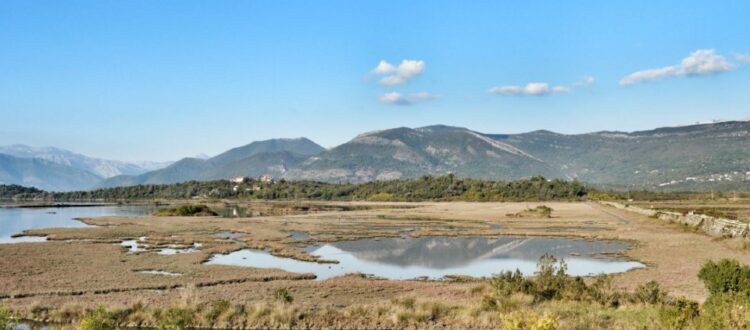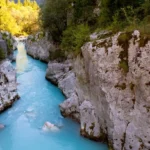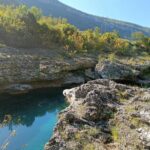Tivat saline – from the dumpsite to the special reserve
Salt has always been one of the most precious foodstuffs in existence. In the background of the Tivat bay, on the brim of Boka Kotorska, the Salina was a source of life and well-being for the locals for over a thousand years, since, in the past, salt had been one of the most highly valued goods on the market. Up until a century ago, the manufacture of salt at the Salina sustained over 300 families. The last salt harvest took place in 1960. The Salina has been losing its significance ever since. What used to be a shining example gradually turned into a landfill.
Nevertheless, half a century after the last salt harvest, the Salina is starting to reclaim its role. It doesn’t have to do with salt, however, but as one of the most significant habitats for birds and remains of the saltpan flora on the eastern Adriatic coast. The Environmental Protection Institute declared the Salina a special nature reserve in 2008. Five years later, it was included in the Ramsar List of Wetlands of International Importance. On that same year, the management of Salina is entrusted to the Public Enterprise for Management of Marine Domain of Montenegro, which gained management authority over protected areas in the maritime domain zone, says Aleksandra Ivanović, MSc, biologist, head of the enterprise’s Department of Sustainable Development. They initiated a partnership with the Centre for Bird Protection and Research of Montenegro, the municipality of Tivat and the Local Tourist Board of Tivat in order to revert a large landfill back to its original purpose.

“The area was extremely neglected”, says Aleksandra as we’re walking along the stone embankment delimiting the former saltpans. A marvellous view spreads before us – a pair of white herons arriving from the coast to land here in search for breakfast. We didn’t have binoculars at hand to take a peek at the breakfast menu for today, so we continued our walk to the first wooden bridge used for seamlessly crossing over the water channels.
Aleksandra explains the work it took: “Different kinds of garbage piled up all the way to this bridge, from soil, construction waste, even septic tank waste, so first we had to clean that section of the Salina, and then reconstruct all 12 bridges. We consequently formed a walking recreational path about two kilometres long. We also placed entrances, information desks, info panels, benches, bird-watching observation points and reconstructed the embankment we’re walking on”.
Her Department colleague, Vojislav Dragnić, in charge of coordinating and monitoring the design and reconstruction of the Salina, where he spends his every available moment, just like Aleksandra, says that the Public Enterprise has invested around 200,000 euros so far in the restoration of the infrastructure and landscape design of the reserve. As we’re standing on the observation point, he’s showing me the layout of the saltpans that are planned to be reconstructed in order to restart salt production for tourism purposes, so that the visitors could envision the centuries-old traditional salt manufacture process. This will enable the tourists arriving from Budva, Tivat and Kotor (three towns encircling the Salina area) to have an outdoor tourist experience alongside the pre-existing activity of birdwatching and recreational tourism.

Special emphasis was placed on the monitoring of the local flora and fauna, for which a sum of 10,000 euros is being invested each year. The Salina was also known as a bird-hunting area. “Thanks to a successful cooperation with the competent authorities, we finally stamped out hunting on the Salina area”, Vojislav proudly states.
Darko Saveljić, ornithologist from the Centre for Bird Protection and Research also couldn’t hide his enthusiasm with the current state of the Salina and considers it one of the most beautiful stories of environmental protection in Montenegro and an example of the synergy of governmental, non- governmental and local entities. This is especially evident when considering Salina’s significance, extending far beyond the borders of Montenegro, since the Salina is located on the Adriatic migration corridor for millions of birds arriving from Siberia, Central and Eastern Europe on their way to Africa, and vice-versa. “When the birds are flying south in the fall, the Salina is their last stop before an arduous flight over the Adriatic Sea. And when they return in the spring, it’s their first feeding spot after the same 200-kilometre return trip from Italy. Also, the Salina is one of the most significant winter habitats and nesting grounds for Montenegrin birds, an Important Bird and Biodiversity Area and an Emerald site under the Bern Convention, with over 114 registered bird species.”
The Salina, besides providing a repose for the weary international flyers, has also become the locals’ favourite past-time and recreation point. Aleksandra points out that the cooperation with the local community has been one of the more successful factors for the development of the Salina. “A substantial surface area of the Salina is privately owned. That’s why access to the Salina is free, the entrance is always open and all members local community are more than welcome”.
“The locals were the ones that showed us how this area was used in old times, and prior to initiating any kind of project on the Salina, we run it by the local community before starting any work. From the very beginning, we invited all interested parties to join us and contribute to this process. And we’ve been open about our plans and goals concerning the reserve from the get-go”, says Vojislav.
Apart from Aleksandra and Vojislav, one of our Salina hosts was the representative of the local community and the only current employee of the reserve, Aleksandar Brinić, who joined us from the opposite side of the Salina. The young man provided his insight into how much the attitude of the locals changed since the Saline became a protected reserve.
See how it’s getting more and more peaceful the deeper we enter the reserve. And it’s an amazing feeling, especially in the peak of the tourist season, when there’s tourists all over the coast”, says Brinić.
“There were forest fires last summer”, I remember aloud, asking Aleksandar how this was met by the local community. I soon find that it’s an example that speaks best of their affection for the area.
“We all came together and saved the Saline from being caught in a big forest fire”, explains Aleksandar. “The fire was getting closer, enveloping the area. We put it out just in time and afterwards pitched in to plant vegetation in order to restore the trees that were lost in the fire. The local community beat a potential catastrophe”, he concludes.
We reach the end of the walkway with our hosts, where we’re met with a panel listing the names of the most significant birds that visit the reserve. Noticing my curiosity, Aleksandra adds that the panels are for educational purposes, which is an aspect of great importance. It is for this purpose that children’s workshops are organised for pupils of Tivat elementary schools, who learn about the importance of the Salina to the local area through games, entertainment and talks. The reserve is a place where people celebrate the World Wetlands Day, Earth Day, and many more.
“The Department for Sustainable Development of the PE of Marine Domain is available to all education institutions for organising field trips to the Salina. As part of the hour-long free educational tour through the Salina, the visitors can hear interesting stories and information on the Salina biodiversity: migratory birds, the specificity of the flora, turtles, fishes and crabs in the reserve, as well as the historical development of the area, the production of salt through the ages, the cultural values and tradition of the region. Birdwatching is also available as part of the visit to the reserve”, Aleksandra explains as we’re nearing the end of our tour through the Salina.
We’re back at the entrance of the Salina where our story began. My hosts and guides made an effort to portray the Salina not just as a natural resource, but as cultural heritage. This is why the Study of Protection of the Salina Cultural Heritage was conducted, so that the Salina is currently in the process of being declared as cultural heritage by the competent Ministry.
At that moment, I had a thought I didn’t share – that this was the conclusion to a story of success which describes the way a landfill turned into a natural and cultural gem. Instead, I thanked them for letting me get a glimpse of that gem. I wished them permanence in their role as protectors of the gem and to increase its renascent shine, to the general satisfaction, primarily of the Euro-African bird travellers, and subsequently the locals, children and tourists.
Ljubisa Pejovic, Parks Dinarides




